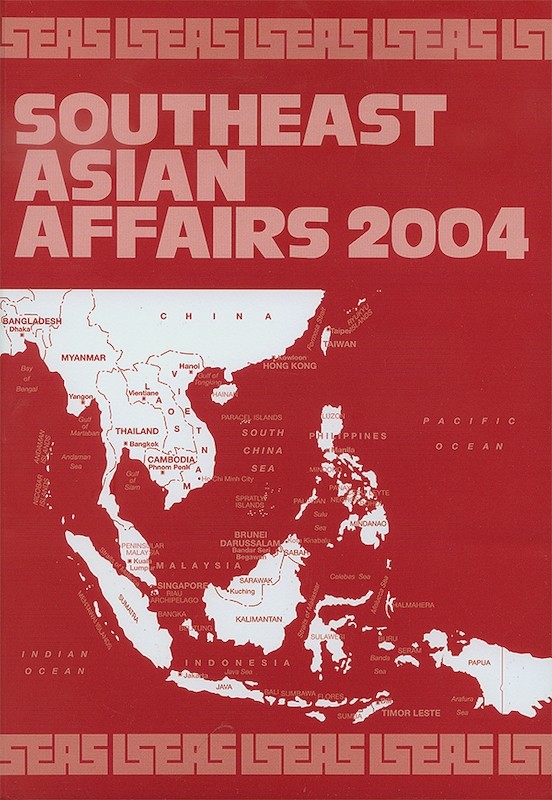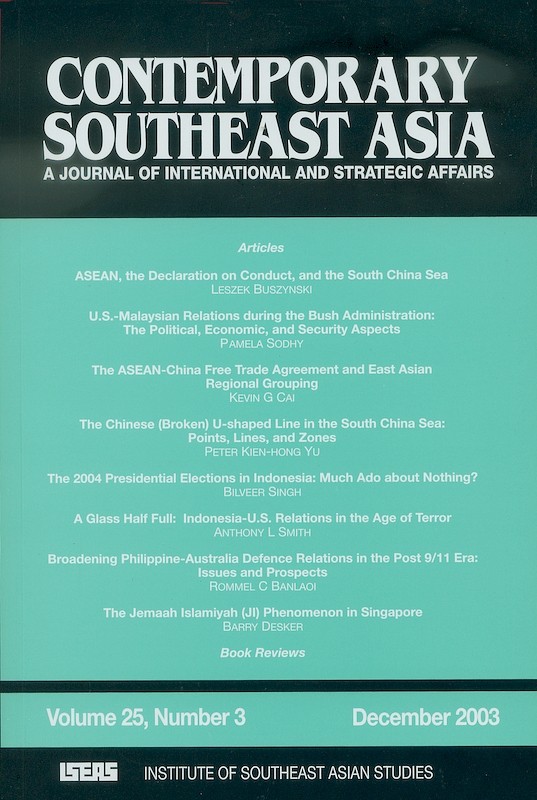Contemporary Southeast Asia: A Journal of International and Strategic Affairs Vol. 25/2 (Aug 2003)

Date of publication:
August 2003
Number of pages:
176
Code:
CS25/2
Contents
-
Contemporary Southeast Asia: A Journal of International and Strategic Affairs Vol. 25/2 (Aug 2003)
-
Preliminary pages
- ARTICLES
-
Funding Terrorism in Southeast Asia: The Financial Network of Al Qaeda and Jemaah Islamiya, by Zachary Abuza, author see abstractThe war on terror has been well executed in Southeast Asia. The arrests of more than 160 Jemaah Islamiya-linked militants since December 2001 have disrupted the capabilities of terrorist operations. JI is less able to execute major attacks than they were a year ago. Yet there are causes for concern: first the group is rebuilding its capabilities. Second, there have been no gains in combating terrorist financing in the region, and to date no terrorist assets or funds have been seized in the region, despite evidence that Southeast Asia has only increased in financial importance to Al Qaeda. JI's financial operations are complex, ranging from legal to illegal, overt to covert. Due to the nature of their funding mechanisms and the fact that terrorism is asymmetrical warfare, combating terrorist financing will not be easy. Yet, choking the terrorist lifeblood is as important as targeting the operational cells themselves.
-
Blood, Sweat and Jihad: The Radicalization of the Political Discourse of the Pan-Malaysian Islamic Party (PAS) from 1982 Onwards, by Farish A Noor, author see abstractThis article looks at the radicalization of the political discourse and strategies of the Pan-Malaysian Islamic Party (PAS) from the early 1980s to the present. It argues that the radicalization of the discourse of PAS has to be understood in the context of the realities of Malaysian politics in the 1980s and 1990s, and how PAS was forced on the defensive thanks to the Malaysian states own aggressive Islamization policy as well as variable factors from abroad such as the Iranian revolution. This article therefore examines how and why PAS made the transition from being a moderate Islamist-nationalist party in the 1960s and 1970s to the more radical and fundamentalist party that it is today. It concludes that the development of PAS then was very much part of a greater global current that was sweeping the Muslim world as a whole.
-
Understanding the Philippines' Economy and Politics since the Return of Democracy in 1986, by Daniel Joseph Ringuet, Elsa Estrada, authors see abstractThis article examines the political and economic reforms since the return of democracy in the Philippines in 1986. The articles main focus exposes the extent to which post-Marcos administrations managed to carry out the necessary reforms in order to re-engage the Philippines as an active participant in the global economy and not just as a mere bystander. Since gaining independence from the United States in 1946, the Philippines has failed to live up to its potential as an economic force in one of the worlds most economically dynamic regions. Partly due to the Marcos era and a high level of foreign debt, combined with persistent poverty and insurgencies, the Philippines seemed to have lost direction. This article will show that this is not the case anymore as the Philippines is moving forward to regain its position among Asia's leading countries.
-
ASEAN Plus Three and the Rise of Reactionary Regionalism, by Mark Beeson, author see abstractThe course of regional integration in East Asia has been shaped by a complex mix of internal and external factors. Although the emergence of initiatives like ASEAN Plus Three appears to indicate that East Asia is assuming a more independent and regionally-oriented place in the international system, this paper argues that the future trajectory of ASEAN Plus Three, and of the region more generally, will continue to be constrained by internal tensions and especially by the continuing influence of the United States. In short, for the foreseeable future, East Asia will be marked by a form of reactionary regionalism in which regional initiatives are designed to mediate and moderate external influences.
-
Conflation of Piracy and Terrorism in Southeast Asia: Rectitude and Utility, by Adam J Young, Mark J Valencia, authors see abstractSince 11 September 2001, the conflation of piracy and terrorism in Southeast Asia has become common in the mass media and government policy statements. The root causes and factors which enable piracy and terrorism are indeed similar, and the perpetrators tactics overlap at the high end of piracy, i.e., ship seizure and hostage taking. However, the objectives of pirates and terrorists are different, and solutions should be fitted to the particular problem. Responses include self-help and foreign naval assistance. But patrols or pursuits by foreign navies in Southeast Asian waters would raise sovereignty concerns. Thus foreign assistance in the building of indigenous maritime enforcement capacity appears to be a more viable long-term solution.
-
Asia Pacific Perceptions of the Financial Crisis: Lessons and Affirmations, by Anthony Milner, author see abstractThis article is a report on a workshop in which historians joined with economists to probe the experience of a traumatic development in the process of economic integration the Asian Financial Crisis of 1997-98 in a selection of Asia-Pacific countries. It is a preliminary investigation, specifically focused on perceptions rather than material consequences, and relying strongly on the participants familiarity with the dominant narratives operating in each of the countries concerned. The investigation notes the resilience of those dominant narratives. It suggests, however, that although the impact of the Financial Crisis on the economies and peoples of the region was dramatic, the impact on public perceptions in the economics sphere was less significant. It is in the social and political spheres that we find the strongest reactions. That is, while the Crisis did not bring about a demand for radical change in economic policy in most Asian countries in particular a demand for a reversal of liberalizing policies the experience of 199798 certainly reinforced a number of national narratives (and national anxieties) which work to promote plurality not integration in the Asia-Pacific.
-
Sino-Japanese Relations: Implications for Southeast Asia, by Jian Yang, author see abstractSino-Japanese relations are still in the shadow of the past. Without much mutual trust, China is wary of Japans military capability and desire to be a political power. China's policy toward Japan has largely reflected its perceptions although the two do not necessarily mirror each other. It is in China's interests to forge a constructive relationship with Japan. However, a series of challenges will test the wills and skills of both leaderships. As a region of strategic importance for both China and Japan, Southeast Asia is poised to benefit from the strategic competition of the two Asian giants. Yet at the same time, ASEAN should play an active role in strengthening regional security order by involving China and Japan into regional confidence-building measures and economic co-operation.
- BOOK REVIEWS
-
BOOK REVIEW: Coping with Globalization: Cross-National Patterns in Domestic Governance and Policy Performance, Edited by Steve Chan and James R. Scarritt, by Helen E S Nesadurai, author
-
BOOK REVIEW: ASEAN's Diplomatic and Security Culture: Origins, Development and Prospects, By Jurgen Haacke, by Amitav Acharya, author
-
BOOK REVIEW: Power in a Philippine City, By Takeshi Kawanaka, by Antonio Pedro Jr, author
-
BOOK REVIEW: Globalization and Democratization in Asia: The Construction of Identity, Edited by Catarina Kinnvall and Kristina Jonsson, by James Cotton, author



